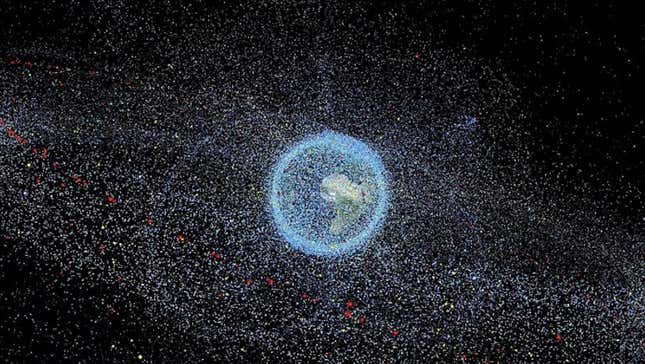
Our ability to efficiently detect space debris has taken an important leap forward, thanks to a new technique in which lasers can spot these potentially dangerous objects during daylight hours.
Researchers from the Institute for Space Research at the Austrian Academy of Sciences have developed a technique in which lasers can measure the position of space debris during daylight conditions. Details of this unprecedented achievement were published in Nature Communications.
Prior to this, lasers could only detect space junk during twilight, as ground stations enter into darkness and objects near the horizon remain illuminated by the Sun’s rays. This small window of opportunity severely minimizes the amount of time available to search for and characterize these orbiting objects, which can threaten crucial satellites.
“We are used to the idea that you can only see stars at night, and this has similarly been true for observing debris with telescopes, except with a much smaller time window to observe low-orbit objects,” explained Tim Flohrer, Head of ESA’s Space Debris Office, in an ESA press release. “Using this new technique, it will become possible to track previously ‘invisible’ objects that had been lurking in the blue skies, which means we can work all day with laser ranging to support collision avoidance.”

Indeed, it’s vital that we document as much space junk as possible to mitigate collisions in space. An estimated 34,000 objects larger than 3.9 inches (10 cm) are currently in orbit around Earth, along with millions of tinier objects, such as bits of spacecraft, chips of paint, rocket parts, and other discarded or lost flotsam-and-jetsam. Even objects measuring a few millimeters across can pose a threat to satellites and spacecraft, as speeds in low Earth orbit can reach 6 miles per second (10 km/s).
Radar can track objects bigger than 3.9 inches but not well enough to manage space traffic, according to an Institute for Space Research press release. Lasers, on the other hand, can track similarly sized objects much more precisely, to an accuracy close to 1 meter. The system works by bouncing lasers off objects in space and then receiving the reflected signals at ground stations, allowing scientists to determine distance.
The new technique differs from conventional methods in that it can track objects during daylight hours, which it does using a combination of telescopes, light deflectors, and filters that track light at specific wavelengths. So even when the sky is bright and blue, scientists can increase a target’s contrast, making previously invisible objects visible. Keys to this method include additional telescopes and the ability to visualize space debris against the blue sky background in real-time.
In daylight tests, the distances to 40 different objects were measured with the new technique, which had never been done before.
“We expect that these results will significantly increase debris observation times in the near future,” said Michael Steindorfer from the Austrian Academy of Sciences in the ESA press release. “Ultimately it means we will get to know the debris population better, allowing us to better protect Europe’s space infrastructure.”
Looking ahead to the future, a wide-scale implementation of this method would involve multiple ground stations located at strategic locations around the planet. This strategy could be supplemented by sensible and enforceable policies to reduce the amount of debris in low Earth orbit, which, sadly, is severely lacking.